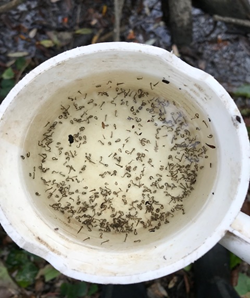2024 Mosquito Surveillance
Adult Mosquitoes (carbon-dioxide trap data)

During autumn and winter, adult mosquito numbers are in decline, and remain low until spring weather triggers adult emergence of many species.
In December, adult mosquito counts except for Culex pipiens, were very low, as is typical for the time of year. Culex pipiens numbers were well above the five-year average (8.377 per trap compared to an average of 2.287). The unusually high numbers were the result of a single site in Redwood City, where the flow to a reclaimed water tank was shut off. The standing water in the tank became a source of mosquito larval production, and hundreds of Culex pipiens mosquitoes were present in District overnight traps. The tank was treated for mosquito larvae and added as a new source to monitor, and the city of Redwood City has been notified that they need to keep the water flowing in the tank.
The following table and graphs show the average number of adult mosquitoes collected per carbon dioxide-baited trap per night during December compared to the five year average for the six most common mosquito species in San Mateo County.
| Species | December 2024 | 5-year December average |
|---|---|---|
| _Culex pipiens_ | 8.4 | 2.3 |
| _Culex tarsalis_ | 0.0 | <0.1 |
| _Culiseta incidens_ | <0.1 | 0.2 |
| _Culex erythrothorax_ | 0.0 | 0.5 |
| _Aedes sierrensis_ | 0.0 | 0.0 |
| _Aedes washinoi_ | 0.0 | 0.0 |
This chart shows the average number of mosquitoes collected per trap during 2024
This chart shows the 5-year average number of mosquitoes collected per trap night by month for the previous 5 years. Data are shown for the six most common species found in San Mateo County.
Larval Mosquitoes (collections from water sources)

Mosquito larval samples are collected from sources of standing water such as marshes, impounds, backyard fountains, fishponds, water under buildings, storm drains, containers, creeks, and tree holes. A District vector control technician uses a dipper to take a sample of the water and visually determines whether any mosquito larvae are present. The technician then transports the sample to the laboratory for the larvae to be counted and identified.
This December, 92 larval samples were collected in the field by vector control technicians and submitted to the lab. Eight different mosquito species were identified in larval samples. The species most often sampled was Culiseta incidens, present in 36 of the 92 samples (39%). This mosquito is active year-round in San Mateo County and is often collected from fishponds, containers holding water, and freshwater impounds. It is not known to transmit disease.
Another commonly collected species was Aedes washinoi (27% of samples). Aedes washinoi is a winter marsh mosquito that breeds in both fresh and brackish waters. It becomes more common at the end of the year, along with other winter marsh mosquitoes such as Culiseta inornate and Aedes squamiger. The sources where these mosquitoes breed are larger and more numerous after rainfall in late fall and winter. They will continue to be found in larval inspections until the seasonal sources dry up during warmer spring weather. Although these species do not currently vector any diseases in this region, they will eagerly bite mammals, including humans.
Page last reviewed: January 3, 2025
